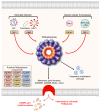It's All in the PAN: Crosstalk, Plasticity, Redundancies, Switches, and Interconnectedness Encompassed by PANoptosis Underlying the Totality of Cell Death-Associated Biological Effects
- PMID: 35563804
- PMCID: PMC9105755
- DOI: 10.3390/cells11091495
It's All in the PAN: Crosstalk, Plasticity, Redundancies, Switches, and Interconnectedness Encompassed by PANoptosis Underlying the Totality of Cell Death-Associated Biological Effects
Abstract
The innate immune system provides the first line of defense against cellular perturbations. Innate immune activation elicits inflammatory programmed cell death in response to microbial infections or alterations in cellular homeostasis. Among the most well-characterized programmed cell death pathways are pyroptosis, apoptosis, and necroptosis. While these pathways have historically been defined as segregated and independent processes, mounting evidence shows significant crosstalk among them. These molecular interactions have been described as 'crosstalk', 'plasticity', 'redundancies', 'molecular switches', and more. Here, we discuss the key components of cell death pathways and note several examples of crosstalk. We then explain how the diverse descriptions of crosstalk throughout the literature can be interpreted through the lens of an integrated inflammatory cell death concept, PANoptosis. The totality of biological effects in PANoptosis cannot be individually accounted for by pyroptosis, apoptosis, or necroptosis alone. We also discuss PANoptosomes, which are multifaceted macromolecular complexes that regulate PANoptosis. We consider the evidence for PANoptosis, which has been mechanistically characterized during influenza A virus, herpes simplex virus 1, Francisella novicida, and Yersinia infections, as well as in response to altered cellular homeostasis, in inflammatory diseases, and in cancers. We further discuss the role of IRF1 as an upstream regulator of PANoptosis and conclude by reexamining historical studies which lend credence to the PANoptosis concept. Cell death has been shown to play a critical role in infections, inflammatory diseases, neurodegenerative diseases, cancers, and more; therefore, having a holistic understanding of cell death is important for identifying new therapeutic strategies.
Keywords: AIM2; ASC; IRF1; MLKL; NLR; NLRP3; PANoptosis; PANoptosome; Pyrin; RIPK1; RIPK3; ZBP1; apoptosis; caspase; caspase-1; caspase-3; caspase-7; caspase-8; crosstalk; infection; inflammasome; inflammation; inflammatory cell death; innate immunity; necroptosis; plasticity; pyroptosis; redundancy.
Conflict of interest statement
The authors declare no conflict of interest.
Figures

References
-
- Karki R., Sharma B.R., Tuladhar S., Williams E.P., Zalduondo L., Samir P., Zheng M., Sundaram B., Banoth B., Malireddi R.K.S., et al. Synergism of TNF-alpha and IFN-gamma Triggers Inflammatory Cell Death, Tissue Damage, and Mortality in SARS-CoV-2 Infection and Cytokine Shock Syndromes. Cell. 2021;184:149–168.e117. doi: 10.1016/j.cell.2020.11.025. - DOI - PMC - PubMed
Publication types
MeSH terms
Grants and funding
LinkOut - more resources
Full Text Sources
Research Materials
Miscellaneous

